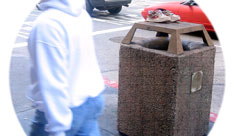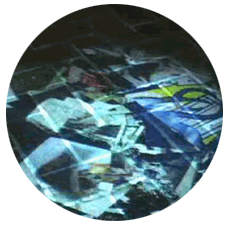|
|
|
|
|
|
|
|
|
|
|
|
||||||||
 |
|
|
||||||
|
|
||||||||
|
|
|
|
||||||
|
|
||||||||
|
|
||||||||
 |
|
|
||||||
|
|
|
|
||||||
|
|
||||||||

|

|
||||||||||||||||||||||||||||||||||||||||||||||||||||||||||
|
|
||||||||||||||
|
|
|
|
|
|
|
|
|
|
|
|
|
|
|
|
|
|
|
|
|
|
|
|
||||||||
|
INTERVIEWS |
|
INTERVIEWS: TRASH TALK |
|
|
We conducted interviews with city planers, waste
managements companies, architects, trash workers, and city inhabitants. The
comments from the first four have been incorporated across various sections
of the website. In this section we focus on the individual interviews with
everyday city dwellers. Individuals were approached on the city streets during afternoon business hours and asked a short list of questions about city trash and their interactions with public trashcans. |
|
|
PROCEDURE |
|
The following were the questions and procedure used to
question individuals in situ in public places within the city.
Full disclosure about the project occurred at the outset of each interview.
|
|
|
RESULTS |
|
|
The 15 individuals (10 male/ 5 female) covered a broad
age range [(1/15) – 20s (3/15) – 30s (5/15) – 40s (3/15) – 50s (1/15) – 60s
(2/15)] and were overwhelming (14/15) local residents to the city or daily
commuters from surrounding areas. Many of them visited the area of the
interview (predominantly Union Square, the plaza at Montgomery BART, and the
Embarcadero) daily and often used the same trashcans in that particular
place on a regular or daily basis (9/15 confirmed this explicitly). Most of
them said they used a public trashcan regularly – from 4 to 40 times a week.
The majority used a public trashcan at least once a day. Individuals were
also shown flashcard images of purposefully cheap objects in various
contexts that sit in a grey area of personal value: old shoes on trash can,
a toy left at the edge of a sidewalk, a magazine shoved in a chain linked
fence, and a personal picture CD-ROM next to a bus stop bench. They were
asked to comment if each item was trash or not and to describe who left the
object behind, and why. We encouraged each individual to describe their
feelings towards trash and its connection to place and people.
Overall the outcome was evenly split between people who
categorized the items trash or not trash. Of the items listed as not trash,
the toy and image CD-ROM had the most perceived value (“lost”), then the
shoes (“left for others” or “left for homeless”), followed by the magazine
that people generally thought of as “litter” left by an inconsiderate person
“probably young”. A large majority (11/15) gave explicit descriptions of who
lost or left the object there and why. Many of them explained that they
would investigate the object further if they found it – from “taking a
closer look” to “picking it up and taking it home”.
|
|
|
Urban Atmospheres at Intel Research |